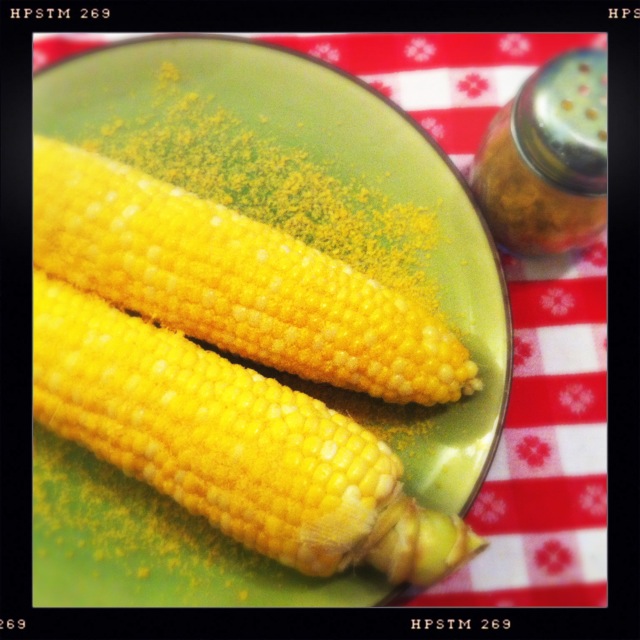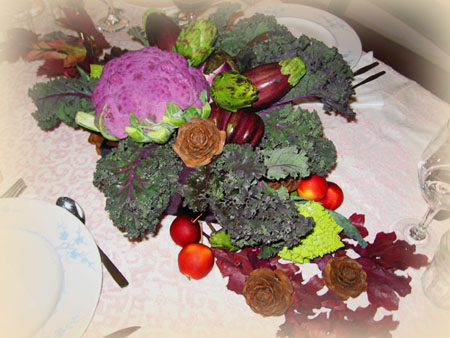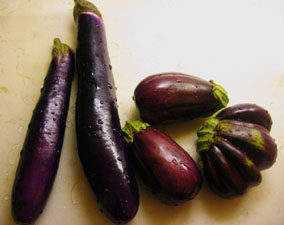It’s summer! I love summer. Summer means gorgeous produce I only get a few months out of the year – corn and tomatoes and peaches and nectarines. Summer means it stays light until late and the days feel like they might go on forever. Summer means bundling up in my warmest scarf and wool socks, turning the oven up to 450, and huddling beside it in my unheated kitchen. Wait, what? Oh, I should have mentioned, this is summer in San Francisco. It is, in fact, colder here in the winter than it is in the summer. But that doesn’t mean it doesn’t get damn cold here ‘twixt May and September.
This has also been a very tired summer for me. Since finishing up my first year of grad school, there has been a distinct increase in bed days and rest days. No problem, that’s what that 450 degree oven is for.
It started with the corn. I love corn. My favorite way to eat summer corn is in fresh corn polenta. But that requires me to shave the kernels off the cobs, which involves a bowl and a knife and stuff. Too tired. I could steam it, but I have a bad habit of putting things on to steam and then getting back into bed, having one of my famous memory blips, and coming back far too late to find a scorched, dry pot. Consulting my trusty copy of Vegetarian Cooking for Everyone (love that “what do I do with this vegetable?” section in the middle!), I learned that corn can be roasted. IN THE HUSK. Here are the steps: Turn oven to 450 degrees. Take corn ears out of CSA box. Lay corn ears onto oven rack. Come back in 15 minutes (give or take, if you space out it’s cool, they are far from burning). Give a little tug and all the husk and silk come gently off at once. WOW.
As an experiment I tried sprinkling it with nutritional yeast. It was pretty great. And I wasn’t the only one thought so! Miss Violet went absolutely bananas. She’s usually pretty good about not being on the table. She might jump up to check something out, but if I say her name or give her tail a little whack she’ll jump down right away. She knows she’s not supposed to be up there. But this time I had to forcibly remove her, picking her up off the table, with her struggling the whole time to get back to the nutritional yeast-covered corn. A little internet research seems to indicate it’s okay for cats to have (or very good for them, depending on the source) so Miss Smushyface was ultimately distracted with a little saucer of her own so I could eat my corn in peace.
I had such a good time with the corn that I tried some zucchini next. My favorite way to eat summer zucchini is Pan-Seared Summer Squash with Garlic and Mint but that requires slicing the zucchini thinly, searing it a few pieces at a time in a pan, flipping and searing more, then repeating until all the slices have been cooked. Mint must be chopped, lemons must be squeezed, garlic must be minced. My new method: Chop zucchini into chunks. Toss with a teaspoon of olive oil, salt, pepper, and herbes de Provence. Put in a parchment-lined baking dish (or rimmed baking sheet) for ~45 minutes or until your desired texture. WOW.
I also tried this with some russet potatoes and cauliflower that came in my box. I don’t have a picture because we ate it too fast. Disher said it was one of the best things he’d ever put in his mouth. I have to concur. Roasted cauliflower is amazing.
So I have my new summer formula. And as an added bonus, it helps keep the house warm on those foggy damp summer nights.
Summer Roast Corn
Fresh corn, still in its husk
Preheat oven to 450. When oven is heated, lay corn on oven rack. Let roast for 15 minutes. Remove corn and, using some sort of heat protection on your hands, pull away the husk. All the silk and husk will just slide right off. Sprinkle with nutritional yeast if desired.
Summer Roast Zucchini
Fresh summer zucchini
Preheat oven to 450. Cut each zucchini lengthwise down the middle, then cut across into 1-inch chunks. Toss with a little olive oil (I use a 1 1/2 teaspoons for 4 zucchini), salt, pepper, and herbes de Provence. Line a baking sheet with parchment. Roast zucchini 45 minutes to an hour, or until meltingly tender and browned.
Summer Roast Potatoes and Cauliflower
Potatoes (I’ve tried Russets and Yellow Finn)
Cauliflower
Preheat oven to 450. Cut veggies into small pieces. Cauliflower florets around 1 inch, potatoes around 1/2 inch. Line a baking sheet with parchment. Roast veggies 45 minutes to an hour, or longer, or until tender and browned.
























